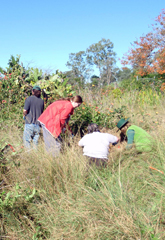The group includes people of varying ages and backgrounds (from children upwards), with both Aboriginal and non-Aboriginal participants. Partnerships have been formed with a range of stakeholders including The Willow Warriors, Blue Mountains off-Road Cyclists and Springwood Bass Fishermen.
Yellomundee Regional Park is eight kilometres north-west of Penrith on the eastern escarpment of the Blue Mountains, west of the Nepean River. It extends for 8.6 kilometres in a north-south direction from Yarramundi in the north to Mount Riverview and Emu Heights to the south. The park is up to one kilometre in width. The park is within the Hawkesbury, Blue Mountains and Penrith local government areas. Urban residential areas lie to the south and north-west of the park, with the rest of the surrounding area taken up by rural, conservation and Aboriginal lands which are predominantly undeveloped bushland.
Group history
The first stage of Yellomundee Regional Park was gazetted in August 2000 and took in Yellow Rock Reserve, previously managed by Blue Mountains City Council. The second stage was added in 2002, making the total area approximately 485 hectares. The Bushcare group formed in May 2009 with a focus on rehabilitation of a former farm, and surrounding weed infestation. Merana Aboriginal Community Association for the Hawkesbury has been fundamental in supporting and co-ordinating activities from the outset, in partnership with NPWS and the Bushcare group.
What do we do?
The Bushcare group works from February through to December, usually one day a month. The work mostly involves weeding, but also includes:
- bush regeneration
- planting
- Aboriginal cultural activities
- brush-matting to contain and define tracks.
Site objectives
- restoration of land that is culturally significant to Aboriginal people
- education of Aboriginal and non-Aboriginal communities about the local environment and Aboriginal values in the landscape
- bushland regeneration and improvement.
Site issues
- weed invasion
- soil erosion
- inappropriate uses such as rubbish dumping, pig-dogging
- protection of Aboriginal sites
- revegetating degraded areas.
Text and image courtesy of the Office of Environment and Heritage
Download group KML



